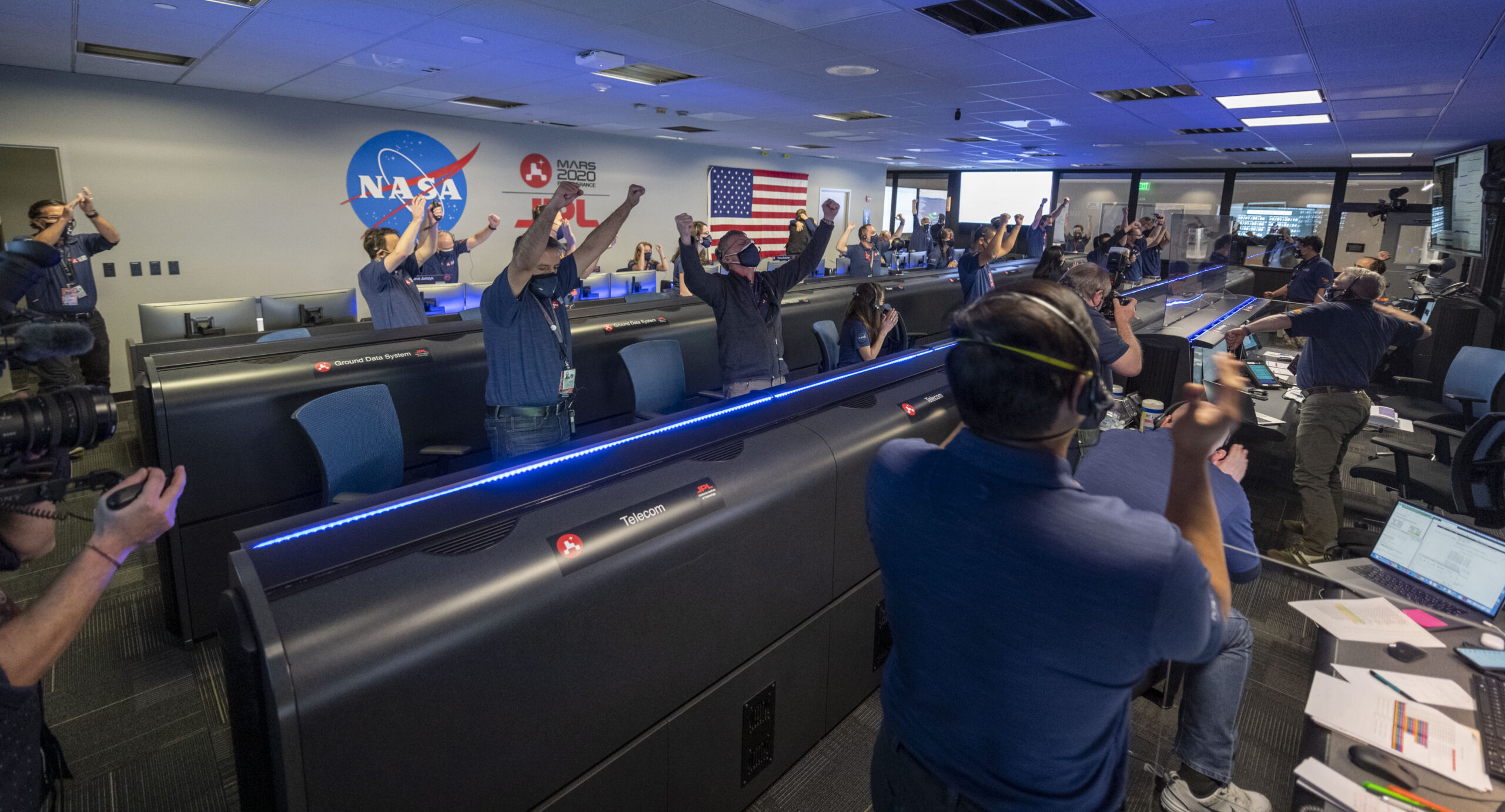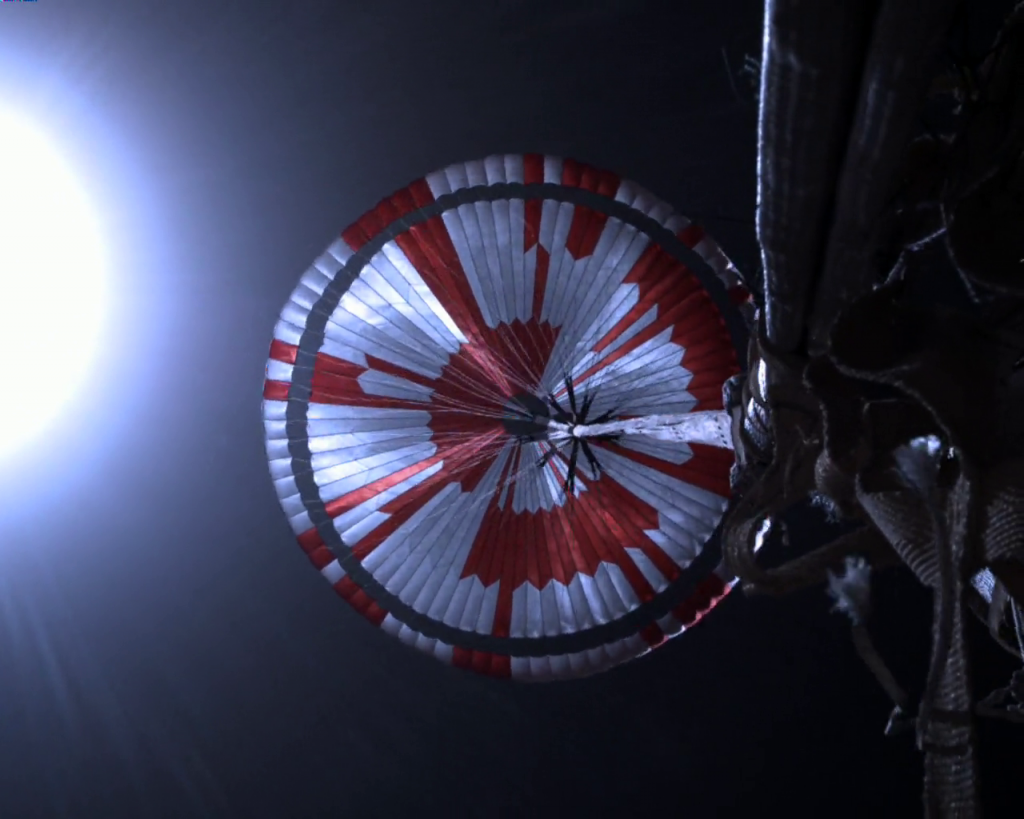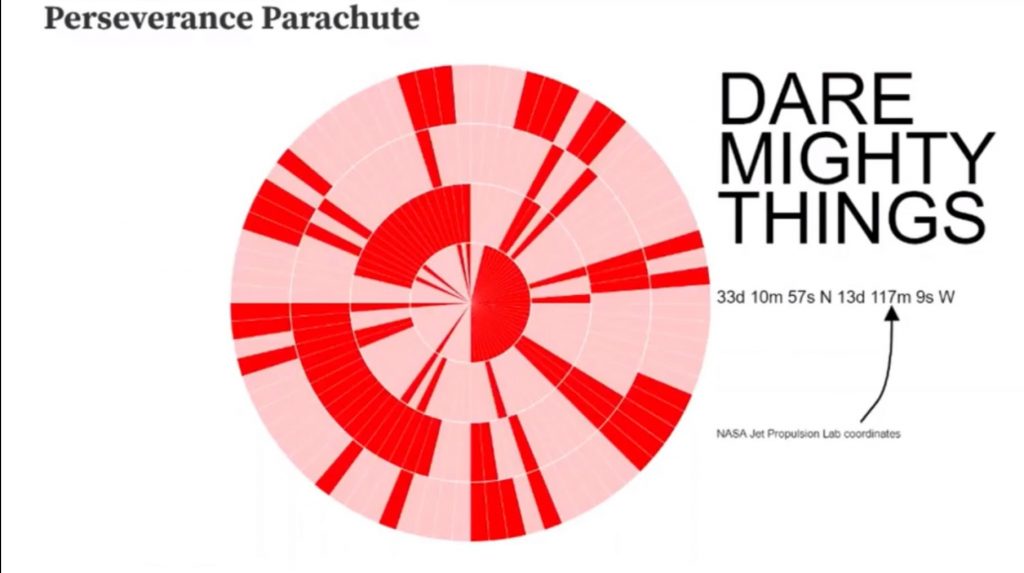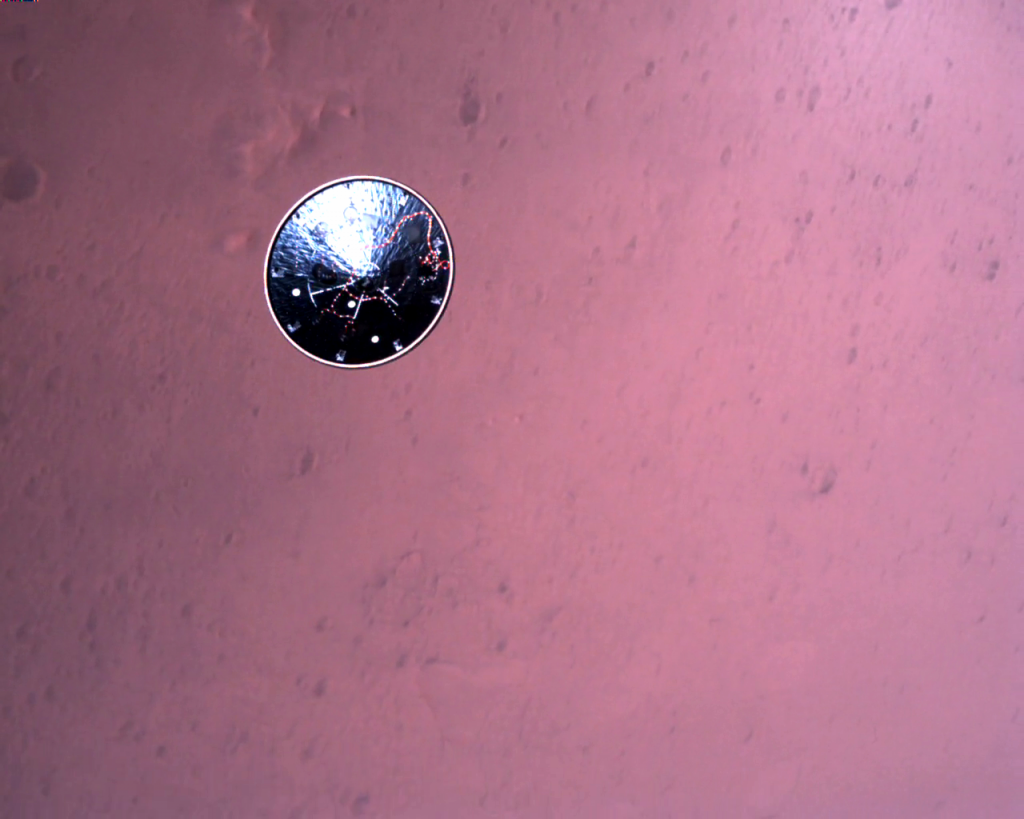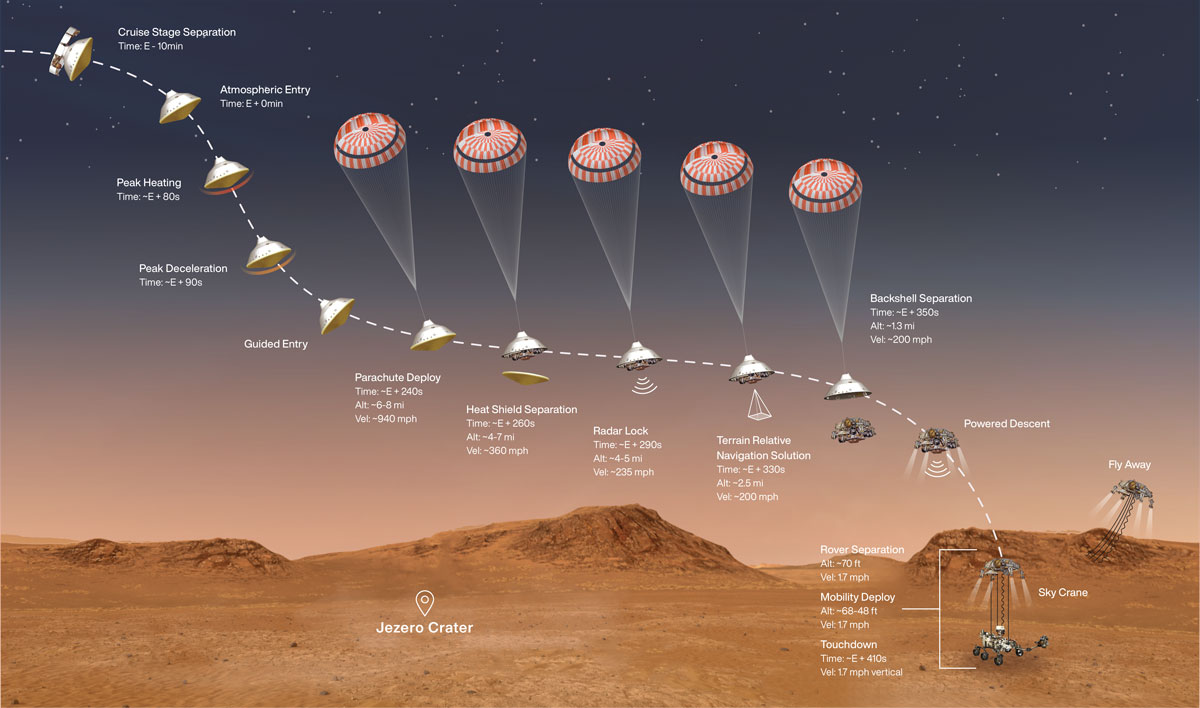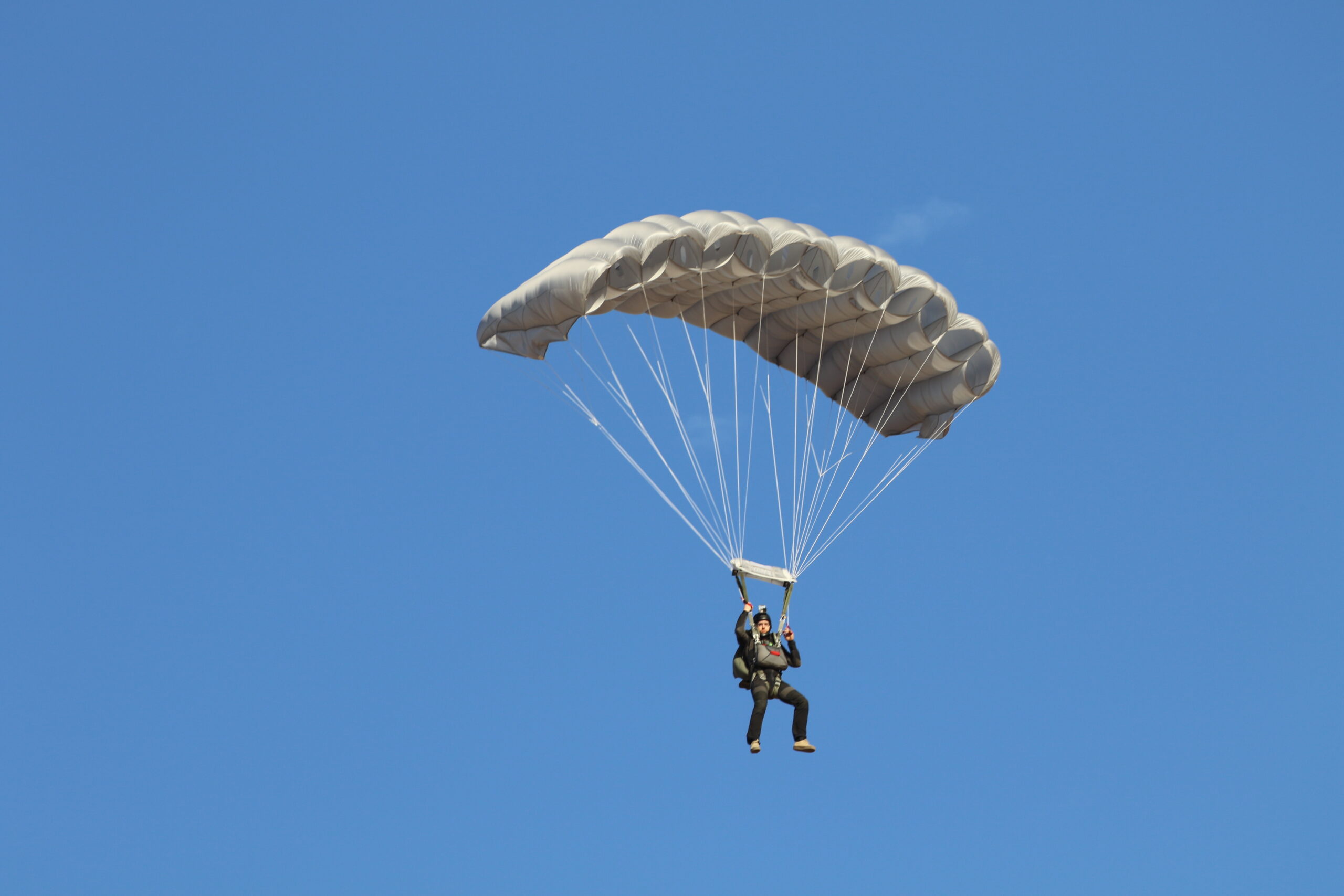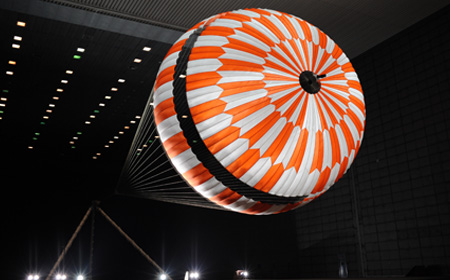Author Archive
Unless you’ve been living on a different planet, you may have already heard that NASA has just landed the heaviest and most sophisticated rover, Percy (OK, officially Perseverance), on the Red planet. What you may not have heard is that a hundred year old company in Southern California, just 50 miles south of NASA JPL, was responsible for designing and manufacturing the state-of-the-art parachute that safely decelerated Percy from supersonic speeds ready for the daring SkyCrane maneuver.
Let’s talk about the fun stuff, parachute details, obviously. The Mars 2020 parachute is 70.5 feet (21.5 meters) in diameter, deploys about 240 seconds after atmospheric entry, at an altitude of about 7 miles (11 kilometers) and a velocity of about 940 mph (1,512 kph), which means the parachute was inflating at about Mach 1.75. To get the full stats on entry, descent, and landing (EDL), check out this article.
With Percy weighing in at over 2,200 lbs, about the weight of a car, this was the heaviest Mars landing to date, which required the strongest parachute ever flown on Mars or any other planet, except Earth! What makes this landing even more special for the parachute world is that it’s the first time anybody has actually seen a parachute perform in the Mars atmosphere. In the past, parachute performance on Mars has been deduced or inferred based on data, but this time we have high speed video, video that will be poured over frame by frame to aid future missions to Mars and other planetary bodies.
The parachute, weighing approximately 180 pounds, was mortar deployed from the back of the aeroshell and inflated in less than a second. Meaning it took less than a second to transform the parachute from a 18 by 26 inch cylinder of nylon, Kevlar, and Technora compressed to the density of wood, into a fully inflated 70.5 ft nominal diameter parachute. The tens of thousands of pounds of force that the parachute generated during this supersonic inflation stressed both the parachute and the vehicle.
Here at Airborne Systems we couldn’t be more proud to have played a part in this amazing feat for humankind. We like to think of Mars 2020 as being the ultimate parachute test vehicle, but in truth the real mission is only just beginning……..
To learn more about what Percy is up to on Mars, check out ‘7 things to know about the Mars Perseverance Mission’ as well as the Perseverance mission page. And if you noticed the unique pattern on the parachute in these images, you’ll like this as well.
Read moreBy now, some of you have figured out there was a secret message in our parachute that just landed on Mars last week.
But what did it say?
Find out the decoding of the message here.
Read more
Mars Perseverance Sol 2: Rover Down-Look Camera NASA’s Mars Perseverance rover acquired this image using its Rover Down-Look Camera. This camera is mounted on the bottom of the rover and looks down at the surface.
Read moreTomorrow, the Perseverance rover, built at NASA’s Jet Propulsion Laboratory in Southern California, will become the next robotic inhabitant of Mars, joining another rover, a lander, and multiple orbiters currently at work on or around the Red Planet. What sets this explorer apart?
There are multiple ways for you to watch history be made tomorrow. You can find out how here.
1. Perseverance is searching for signs of ancient life.
Previous NASA missions have discovered evidence that Mars once hosted running water before becoming a frozen
desert. Earlier in its history, Mars had warmer environments at the surface that could have supported microbial life.
Perseverance aims to take the next step, seeking, as a primary goal, to answer one of the key questions of
astrobiology: Are there signs (or biosignatures) of past microbial life on Mars? This demanding science goal requires a new suite of cutting edge instruments to tackle the question from many angles.
Two of them will play a particularly important role in the search for potential signs of past life: SHERLOC (short for Scanning Habitable Environments with Raman & Luminescence for Organics & Chemicals), which can detect organic matter and minerals, and PIXL (short for Planetary Instrument for X-ray Lithochemistry), which maps the chemical composition of rocks and sediments. The instruments will allow scientists to analyze these features together at a higher level of detail than any Mars rover has done before. Perseverance will also be able to use some instruments to gather science data from a distance: Mastcam-Z’s cameras can zoom in on rock textures from as far away as a soccer field, while SuperCam will use a laser to zap rock and regolith (broken rock and dust) to study their composition in the resulting vapor. RIMFAX (short for Radar Imager for Mars’ Subsurface Experiment) will use radar waves to probe geological features underground.
2. The rover is landing in a place with a high potential for finding these signs of past microbial life.
Terrain that is interesting to scientists can be challenging to land on. Thanks to new technologies that enable Perseverance to target its landing site more accurately and avoid landing hazards autonomously, the spacecraft can safely touch down in an intriguing ancient river delta with steep cliffs, sand dunes, and boulder fields. Jezero Crater is a 28-mile-wide (45-kilometer-wide) basin located in the Martian northern hemisphere. Sometime around 3.5 billion years ago, a river there flowed into a body of water about the size of Lake Tahoe, depositing sediments in a fan shape known as a delta. The Perseverance science
team believes this ancient river delta and lake deposits could have collected and preserved organic molecules and other
potential signs of microbial life.
3. Perseverance is also collecting important data about Mars’ geology and climate.
Context is everything. Mars orbiters have been collecting images and data from Jezero Crater from about 200 miles (322 kilometers) above, but finding signs of ancient life on the surface requires much closer inspection. It requires a rover like Perseverance. Understanding Mars’ past climate conditions and reading the geological history embedded in its rocks will give scientists a richer sense of what the planet was like in its distant past. Studying the Red Planet’s geology and climate could also give us a sense of why Earth and Mars – despite some early similarities – ended up so different.
4. The Perseverance rover embodies the NASA – and the scientific – spirit of overcoming challenges.
Getting the spacecraft to the launch pad during a pandemic, searching for signs of ancient life, collecting samples, and
proving new technologies are no easy feats. Nor is a soft touchdown on Mars: Only about 50% of Martian landing attempts, by any space agency, have been successful. The mission team draws inspiration from the name of its rover, with particular awareness of the challenges the entire world is experiencing at this time. With that in mind, the mission installed a special plate to honor the dedication and hard work of the medical community and first responders around the globe. The team hopes to inspire the entire world, and future explorers, to forge new paths and make discoveries on which the next generation can build.
5. Perseverance is the first leg of a round trip to Mars.
The verification of ancient life on Mars carries an enormous burden of proof. Perseverance is the first rover to bring a sample caching system to Mars that will package promising samples for return to Earth by a future mission. Rather than pulverizing rock the way Curiosity’s drill does, Perseverance’s drill will cut intact rock cores that are about the size of a piece of chalk and will place them in sample tubes that it will store until the rover reaches an appropriate drop-off location on Mars. The rover could also potentially deliver the samples to a lander that is part of the planned Mars sample return campaign by NASA and ESA (the European Space Agency).
Once the samples are here on Earth we can examine them more precisely with instruments too large and complex to send to Mars, providing far more information about them than even the most sophisticated rover could.
6. Perseverance carries instruments and technology that will help pave the way for future human missions to the Moon and Mars.
Among the future-looking technologies on the Mars 2020 Perseverance mission that will benefit human exploration is Terrain-Relative Navigation. As part of the spacecraft’s landing system, Terrain-Relative Navigation is the main reason Perseverance can explore a place as interesting as Jezero Crater. It will enable the descending spacecraft to quickly and autonomously comprehend its location over the Martian surface and modify its trajectory. This technology will provide invaluable assistance for both robotic and crewed missions landing on the Moon.
Perseverance will also have more autonomy on the surface than any other rover, including self-driving smarts that allow it to cover more ground in a day’s operations with fewer instructions from engineers on Earth. This fast-traverse capability (courtesy of upgraded sensors, computers, and algorithms) can translate into more science over the length of the mission. What’s more, it will make exploration of the Moon, Mars, and other celestial bodies more efficient for other vehicles.
In addition, Perseverance carries a technology demonstration – a proof-of-concept experiment – called Mars Oxygen In-Situ Resource Utilization Experiment (MOXIE). This instrument will produce oxygen from Mars’ carbon dioxide atmosphere, demonstrating a way that future explorers might produce oxygen for rocket propellant as well as for breathing.
Two other instruments will help engineers design systems for future human explorers to land and survive on Mars: The MEDLI2 (Mars Entry, Descent, and Landing Instrumentation 2) package is a next-generation version of what flew on the Mars Science Laboratory mission that delivered the Curiosity rover, while the MEDA (Mars Environmental Dynamics Analyzer) instrument suite provides information about weather, climate, and surface ultraviolet radiation and dust.
7. You will get to ride along.
The Mars 2020 Perseverance mission carries more cameras than any interplanetary mission in history, with 19 cameras
on the rover itself and four on other parts of the spacecraft involved in entry, descent, and landing. As with previous Mars missions, the Mars 2020 Perseverance mission plans to make raw and processed images available on the mission’s website.
If all goes well, the public will be able to experience in high definition what it’s like to land on Mars – and hear the sounds
of landing for the first time with an off-the-shelf microphone affixed to the side of the rover. Another microphone on SuperCam will help scientists understand the property of rocks the instrument is examining and can also listen to the wind.
If you are among the 10.9 million people who signed up to send your name to Mars, your name is stenciled on one of three silicon chips embedded on a plate on the rover that carries the words “Explore as one” in Morse code.
Article author: NASA
See Also: The Final Countdown
Read moreClick here to read this article in Manufacturing in Focus
Just 12 seconds long, the Wright brothers’ manned flight near Kitty Hawk, North Carolina, changed the world forever. Traveling 120 feet at 6.8 miles per hour, the Wright Flyer made what is considered humanity’s first real flight. It was the start of a revolutionary industry: aviation.
Built by Orville and Wilbur Wright, the heavier-than-air biplane made four flights on December 17, 1903, the last almost a minute long and spanning 852 feet (about 260 meters).
For the brothers — neither of whom graduated high school, but who designed and manufactured bicycles and had an unwavering interest in everything mechanical — and the world, that cold December day ushered in an entirely new mode of transportation.
In 1919, 16 years after the historic Wright Brothers flight, innovator Leslie Irvin both made the world’s first free-fall parachute descent, and formed the company that was to become Airborne Systems, the Irvin Air Chute Company in Buffalo, New York. It was, as we show, a company dedicated to airborne safety and innovation.
The business quickly became an industry pioneer. The company produced the X-type Paratroop Parachute Assembly in 1940, used during the Second World War and for decades after. In 1951, the company joined forces with Martin-Baker to create the first autonomous pilot-seat ejection system, saving countless lives.
Other firsts followed, including the development of the recovery system for Discoverer 13, the first object to be recovered from orbit; landing drag parachutes for the Space Shuttle Endeavor; the creation of the state-of-the-art Intruder system for the U.S. Army, and key innovations of systems for Boeing’s CST-100 and NASA’s Orion, and other programs.
World leader
Celebrating its 100th anniversary in 2019, the pioneering company founded by Leslie Irvin is today known as Airborne Systems. With locations in Pennsauken, New Jersey, Santa Ana, California, and a training facility in Eloy, Arizona, Airborne Systems designs, engineers, and manufactures leading products for military and aerospace customers to this day.
Never compromising on materials or quality, the company is known for best-in-class parachutes, delivery parachutes, GPS-guided cargo delivery systems, revolutionary deceleration products for space and air, and other unique technologies.
“We’re pretty much the biggest parachute manufacturer around, especially when it comes to recovery and specialized applications,” says Charles W. Lowry. Graduating as a mechanical engineer from Cal Poly Polmona, Lowry started with Airborne Systems in 2012 as an intern, became full-time two years later, and is today Project Engineering Supervisor.
He is one of about 500 highly qualified staffers among the company’s three facilities, which includes disciplines such as aerospace engineers, mechanical engineers, analysts and departments responsible for manufacturing engineering and production engineering.
Tried and tested
For over a century, Airborne Systems has spearheaded the creation of unique products marrying safety with function. Serving American and allied military clients, the company counts aerospace, special operations, global humanitarian groups, and various levels of government among its clients. Although the sectors may differ, Airborne’s commitment to best-in-class quality products and dedication to safety remains the same.
In business for more than a century, Airborne Systems has proven itself to customers worldwide time and again. And the main reason that well-known entities like NASA, the U.S. Army and others keep coming back to Airborne goes far beyond just manufacturing capabilities.
Aerospace giants count on Airborne for the extensive knowledge and experience gained over 100 years of creating products that are scrupulously designed but innovative, exhaustively tested, and made from the most reliable materials in existence.
“Most companies do not design their own parachutes. They want the best,” comments Lowry. “We need to be involved at some level, and most companies need outside expertise and outside manufacturing and support.”
Receiving specifications from clients, the company builds parachute systems around those requirements; in some cases, they are based on past space programs going all the way back to Gemini and Apollo missions.
Airborne rigorously tests massive, multi-million-dollar parachute systems 50 or 100 times if necessary. “Some big test programs go into the space systems, especially ones that are going to be human-rated,” says Lowry. “Nobody takes the lives of astronauts lightly, and there are all sorts of tests we do to make sure the parachutes are going to work every time.”
More than parachutes
When Leslie Irvin formed the company bearing his name, he developed parachute systems for biplanes, balloons, and other slow aircraft of the time. Today, hypersonic planetary entry sees remarkable speeds of Mach 10 or even Mach 12 (some 9,200 mph; to put it into perspective, breaking the sound barrier requires reaching Mach 1, or a velocity of some 770 mph).
Parachutes are rarely used above Mach 3 (2,300 mph), so for the likes of NASA, Airborne has developed other aerodynamic decelerators, such as Hypersonic Inflatable Aerodynamic Decelerators – HIAD for short. These are used to decelerate payloads and objects going faster than Mach 3 or Mach 5.
“When we say ‘space and recovery,’ we don’t want to say we’re just a parachute company, which doesn’t tell the whole story,” comments Lowry. “We specialize in aerodynamic decelerators, whether that’s subsonic troop parachutes, or hypersonic space re-entry decelerators.”
Launched on July 30th, NASA’s Mars 2020 Perseverance Rover recently passed the halfway mark – 146.3 million miles or 235.4 million km – on its way to the Red Planet.
Airborne’s expertise will play a vital role, greatly decelerating the Mars 2020 when “the spacecraft hits the Red Planet’s atmosphere like a 11,900 mph (19,000 kph) freight train on Feb. 18, 2021,” according to NASA’s website. Replacing the Curiosity Rover which has explored Mars since 2012, the Mars 2020 spacecraft will be slowed down to about 200 mph thanks in part to a crucial role that the parachute system created by Airborne plays.
First off, however, the spacecraft’s heat shield will play its assigned key role in the demanding EDL (entry, descent, and landing) phase – reaching an external temperature of approximately 2,370 degrees Fahrenheit (1,300 degrees Celsius) as it slows the spacecraft to less than 1,000 mph (1,600 kph).
It’s at this point that a supersonic parachute measuring 70.5 feet (21.5 meters) in diameter deploys at about seven miles (11 km) out.
From there, a series of carefully calculated events takes place. The heat shield separates from the craft and falls away, the parachute slows the Mars 2020 to 200 mph (320 kph), and is then cut free, and the spacecraft further slows itself through retro-propulsion rockets. The landing is challenging, particularly since Mars’s atmospheric density is low, just two percent of that on Earth.
“For a parachute to work, you need some sort of atmosphere, you need air,” says Lowry, “so there’s a lot of special challenges that come with that. How to get the Rover onto the surface of Mars is quite complex, because of the atmosphere. The parachute is a major part of it, slowing it down to, say, 80 percent of what it needs to be slowed down to, [before the retro-propulsion rockets kick in]. If it was just the parachute, the Rover would still hit the ground at 200 mph.”
Military precision
Known worldwide for its innovative parachute design and manufacturing, Airborne Systems is proud to count the U.S. Army and other friendly countries’ military establishments among its clients.
Matt Zwicker, Senior Research and Development Engineer, has been at Airborne’s New Jersey facility for the past half-decade, although he’s been with the company for the past nine years – spending the first four at the space and recovery division in California. He focuses on parachute certification, testing, and product design.
When Airborne modifies existing products or introduces new ones, Zwicker’s department builds components for testing, and runs test sessions, air drops and live jumps to ensure that safety, and performance and reliability are up to its exacting standards.
Prior to use, Airborne parachutes must not only pass extensive testing, but also meet demanding certifications.
Earlier this year, the company’s Intruder® 210R parachute received Federal Aviation Administration (FAA) TSO-C23(f) certification. Representing the most recent and stringent certification standard from the FAA, the Intruder 210R is compatible with Instructor parachutes from 170 to 230, and meant to use with Airborne’s iRaider harness system.
To new standards
For the company, the FAA certification represents another bold step forward, and the culmination of hundreds of hours of research, design modifications, and test jumps. Going back around 2015 and completed in 2018, the Intruder 210R represents the exhaustive testing program performed by Airborne Systems to ensure the highest levels of safety, reliability, and performance – an activity complemented by the years of research and experience in producing countless other fine products.
What makes the Intruder 201R unique is that it’s a parachute for military instructors.
Traditionally, military instructors were using sport skydiving equipment purchased from other skydiving manufacturers. Since these systems were not truly indented for military environments or users, this resulted in higher potential for injury.”
“The military came to industry, and said they wanted instructor parachutes that were an alternative to the ones they were currently using,” states Zwicker, “so we needed a reserve parachute that could meet FAA certification for that purpose, because you have to deploy it at lower altitude.”
Since existing parachutes were certified to older FAA certifications, this presented challenges, especially with total velocity of the parachute after deployment is complete.
“The easiest way to make a parachute move slower is to make it bigger,” comments Zwicker. “But if you make a parachute much larger, and still inflate it quickly, the load on the jumper becomes high enough to risk injury.”
Calling it an “over-constrained problem that couldn’t be met easily,” Zwicker and his team took the Intruder parachute – what the US Army calls RA1 – and modified the parachute design, including the airfoil section, the way the wingtips are constructed, and how the brakes were configured, to find a compromise that met both total speed limit and the altitude loss requirement, while also able to carry enough weight to meet military-instructor specs.
“That’s why the TSO-C23(f) certification was such a big deal for us, because there’s not a lot of ways to solve a problem, and we managed to find one,” says Zwicker. “The previous revision of that standard – C 23E – nobody ever met it, so no parachutes were certified to it and the FAA eventually canceled it.”
With so many internal capabilities, Airborne Systems’ expertise sees the company working with military and space agencies in friendly countries worldwide. Says Lowry, “What we do at Airborne Systems is not just provide off-the-shelf parachute systems: it’s more of a service where we solve very complex problems that most of our competitors can’t.”
Read moreWe are very excited to be a mix of physically and digitally present at IDEX 2021! The pandemic has sure thrown some curveballs for the tradeshow industry, but we are lucky enough to have found a safe solution for you and our staff to successfully meet at the show with the help of the Aerospace and Defense USA Showcase and Kallman Worldwide.
Physically attending the show?
Our brand will be featured on the Aerospace and Defense USA SHOWCASE booth located at booth number C01-07. We will be digitally available to meet with you during show hours simply by visiting the booth. Just mention Airborne Systems to a Kallman Worldwide employee and they will direct you to a sanitized work station where we will be eagerly waiting your arrival. In addition, we are happy to set up appointments in advance to ensure you meet with the most suitable Airborne Systems representative.
Not attending the show but still want to meet?
You can visit our virtual booth for IDEX via this link. Register your access online and once inside, search for “Airborne Systems” and click on the third tab called “exhibit hall” and navigate down to the Airborne Systems booth (7th from the top). Once you are at the booth, you can text or video chat with anyone that is online, leave us a message, and much more!
Thank you and “see” you at the show.
Stay safe!
Read moreAirborne Systems is pleased to announce the Intruder® 210R reserve parachute has received Federal Aviation Administration (FAA) TSO-C23(f) certification, the latest and most stringent FAA certification standard. The Intruder® 210R is offered for use with our iRaider harness system, and is compatible with the full range of Instructor parachutes from 170 to 230. This integrated system combines the reliability, safety and high glide ratio of the RA series with a lightweight harness container to meet the demands of military freefall instructors.
Airborne Systems is very proud of our dedicated and passionate R&D team. Countless hours, hundreds of test jumps, and multiple design iterations all played a key role in meeting all the requirements for TSO-C23(f) certification. The TSO-C23(f) certification applies to equipment intended to be used as a reserve or emergency parachute and is the most stringent set of testing requirements certified by a national authority.
Read moreWe talked about our Journey to Mars, then we talked about the official launch to Mars, but now what? What comes next?
Since we have a bit of time before we land on Mars on February 18, 2021 20:00 UTC, here is some key information on the mission itself, parachutes aside.
“Perseverance is now on its way to seek signs of ancient life and collect rock and soil samples for possible return to Earth. Along with the rover is the Ingenuity helicopter, a technology demonstration that will be the first powered flight on Mars. The rover will arrive on the Red Planet on Feb. 18, 2021.
The mission addresses high-priority science goals for Mars exploration, including key astrobiology questions concerning the potential for life on Mars. It not only seeks signs of habitable conditions on Mars in the ancient past, but also will search for signs of past microbial life.” (From Mars.Nasa.gov)
You can keep up with the mission status continuously on NASA’s page here.
The Airborne Systems team is so proud of the history being made here, and ecstatic to play a role in such a momentous feat.
Safe travels, Perseverance!
Read moreSomething BIG is happening! The launch window for the Atlas V541 Rocket opens 7/30/20 at 7:50am EST, 4:50AM PST. This launch will mark the beginning of a seven month countdown to when the Perseverance rover will begin its entry, decent, and landing sequence on its last phase of its journey to the surface of Mars. Perseverance will touch down on Mars on Feb 18, 2021. Airborne Systems is proud to work with NASA’s Jet Propulsion Laboratory and provide the supersonic parachute for this application. The parachute has been fully qualified though rigorous material and seam testing, mortar deployment tests, wind tunnel tests in the world’s largest wind tunnel, and two supersonic flights as a part of NASA’s ASPIRE Sounding Rocket Test series. The Perseverance Rover is 17% heavier than its predecessor, Curiosity, requiring the most robust parachute ever to fly to Mars.
The Perseverance rover, built on the heritage of the Curiosity rover, boasts several impressive capabilities. It will cache rock samples in preparation for return back to Earth, it will produce its own oxygen as a part of an experiment to prepare for human exploration, and it will carry an autonomous flying vehicle that will make history by being the first powered flight vehicle on Mars. Additionally, this this mission will acquire images of the supersonic parachute deployment and flight as well as images and sound of the landing sequence and touchdown of the Perseverance rover on the Martian surface.
Airborne Systems is extremely proud to be a part of this very exciting mission.
Join us as we watch this historic mission begin here: https://mars.nasa.gov/mars2020/timeline/launch/watch-online/
#CountdownToMars
Checkout our article: Airborne Systems’ Journey to Mars
Read more

